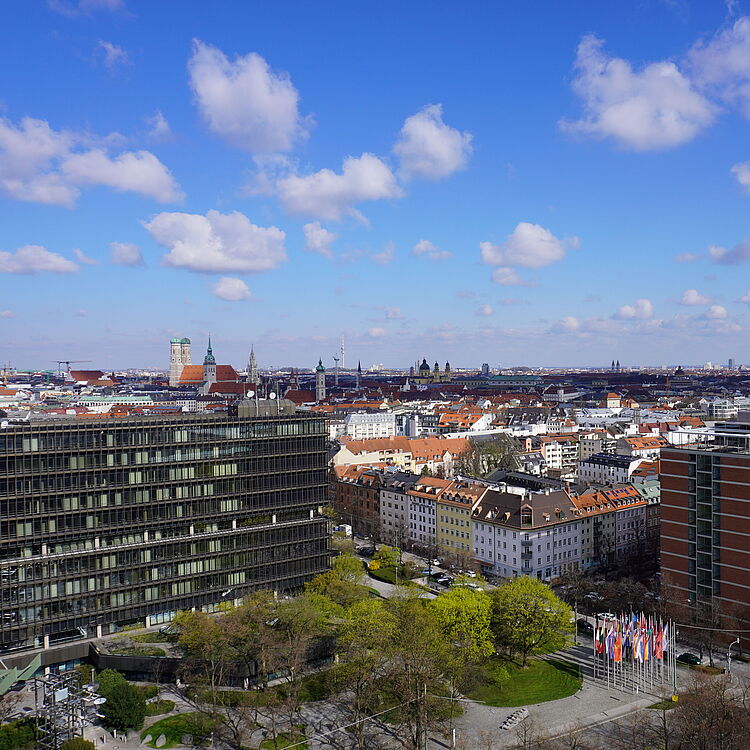
Photo: Deutsches Museum
Tours to the viewing platform
Museum tower with a view
312 steps up to the panoramic view: At weekends and during the holidays, we offer regular tours to the viewing platform on the Deutsches Museum tower. The tower can be seen from afar and is a landmark of the Deutsches Museum. It is characterised by its beautifully designed façade elements. Where a clock is usually installed, the Museum Tower displays air pressure, temperature, wind and humidity.
Panoramic tour: information at a glance
- Height of the viewing platform: 65 metres above the Isar
- The tower tours take place regularly at weekends, on public holidays and during the Bavarian school holidays. The first tour starts at 9:30, the last ascent at 16:00.
- Duration of a panoramic tour: including ascent and descent approx. 30 minutes.
- All participants need a ticket for the tour in addition to their admission ticket, €5 (free for museum members ). Available at the information desk in the entrance hall.
- Children aged 6 and over.
- The tour is not barrier-free: There is a lift up to level 3, from level 3 it is another 185 steps on foot to the viewing platform.
Weather values are displayed on the tower façade. Here you can see the barometer and the thermometer. There is a weather station with modern measuring instruments on the mast. Photo: Deutsches Museum, Alexander Goettert
The museum tower and its weather displays
The tower, visible from afar, is a landmark of the Deutsches Museum. It was already standing around 1911, even before the museum building was opened in 1925. Museum founder Oskar von Miller wanted to create an architectural landmark for the museum that would also be used for scientific purposes. The façade elements barometer, thermometer, hygrometer and anemometer show what the tower primarily stands for: it's all about the weather. What will the weather be like tomorrow? How will the climate change in the long term? To answer such questions, we need precise measurements. A modern weather station is located high up on the tower's mast.
Modern weather station at the top of the tower
The weather has been measured at the Deutsches Museum since 1925. With one station on the museum tower and one in the outdoor area, we can obtain extensive measurement data. The tower is a rather unusual location, as some of the instruments here are more than 80 metres above the ground. It is therefore particularly interesting to compare the measured values with those at ground level. The weather station on the museum tower measures with modern instruments. The readings are sent to DTN meteogroup for analysis and the values are then displayed on the façade elements.
The values for the Munich - Museum Tower station and a 4-day forecast can be viewed here on the DTN website .
Picture gallery – museum tower
Building history of the Deutsches Museum
You can find out more about the history of the Deutsches Museum and the ensemble on the Museum Island on our website on the history of the Deutsches Museum.

Photo: Deutsches Museum, München | Reinhard Krause
Foucault's Pendulum inside the tower
30 kg lead ball attached to a 60 metre long steel cable at the top of the tower: The pendulum is one of the most famous demonstrations in the Deutsches Museum. In 1851, the French physicist Jean Bernard Léon Foucault demonstrated the rotation of the earth in a spectacular show at the Pantheon in Paris. To all observers, the pendulum's plane of oscillation appears to rotate slowly. However, the change is actually due to the rotation of the earth.
Picture gallery of the pendulum

Sendeantenne mit Anpassung und Blitzschutz auf dem Museumsturm. Photo: Deutsches Museum
Radio Eule - Medium wave transmitter
The Deutsches Museum has been operating a medium-wave transmitter since 2018: Radio Eule. It is a reminder of the beginnings of radio broadcasting in Germany. Radio Eule broadcasts with 10W EIRP on a frequency of 1500 kHz and can be heard in almost the entire Munich city area. In exceptional weather conditions - usually at night - and with special aerials, reception is even possible as far away as Finland. Regular reception reports that we receive from radio amateurs provide very good evidence of the coverage.
The antenna is suspended from the mast on the museum tower at an angle downwards towards the north-east (span approx. 80 metres). The base of the antenna is at the top of the museum tower (h = approx. 66 m).
More about Radio Eule on the museum's website.
PS - The owl is the mascot of the Deutsches Museum and is also part of our logo, which you can also see here on the website.


